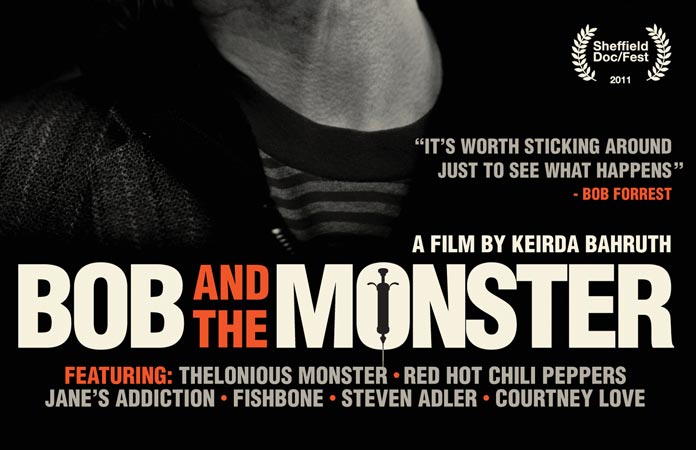DVD Review: Bob And The Monster: The Story Of Bob Forrest
Published on October 30th, 2013 in: Current Faves, Documentaries, DVD, DVD/Blu-Ray Reviews, Movie Reviews, Movies, Music, Reviews |How does a man go from being self-described as one of the “biggest assholes ever to live” to being credited with saving numerous lives as a drug counselor? How did he go from leading L.A.’s premier “drunk rock” band to being the subject of a moving, thoughtful documentary in which music’s luminaries eulogize him warmly without him even being dead?
First, Bob Forrest did a lot of drugs. Then, he hit rock bottom. Then, he did some more drugs and had to hit rock bottom again. Eventually, he rebuilt himself into a sometimes respected, sometimes controversial addiction specialist.
Director Keirda Bahruth spent six years making Bob And The Monster, a documentary of Bob Forrest’s journey of addiction and redemption. Told with archival footage, claymation, and animation, as well as new music from Bob Forrest, it’s a touching, sometimes infuriating, and illuminating movie.
Bob Forrest fronted Thelonious Monster, a “traveling circus” of a band (there were seven people in the original lineup, four of those being guitarists). They were part of the electric atmosphere of the L.A. music scene in the early ’80s, alongside Jane’s Addiction, Fishbone, and the Red Hot Chili Peppers. As Courtney Love points out in Bob And The Monster, it was important to be a junkie in L.A. in the ’80s. And so Bob was.
Their first album was a critical success, being compared to Exile On Main St. and The New York Dolls’ debut. Bob, himself, was compared to John Lennon for his confessional, diary-like lyrics, and he had an amazing bluesy, raw voice. The footage of Thelonious Monster’s live shows in Bob And The Monster is thrilling (as a former 14-year-old Monster fanatic, and from those pre-Internet days where you had to stay up and tape Night Flight in hope of catching something good, I was giddy to see it. And then I dug all my Thelonious Monster records out of the basement and lost an entire afternoon to them, happily).
His first experience with heroin is recreated in claymation. It is grungy and awful. That is the beginning of an end of him, of course. Coupled with Bob’s head being turned by studio suits who convince him that he’s better off without The Monster and that he should record a frankly terrible solo album, you can see the start of his slide to the bottom.
The problem with junkies, though, is it takes so long for their real bottoming out to happen. Forrest was in and out of rehab over 20 times before he finally got clean. Meanwhile, he burned through his RCA solo money and reunited with Thelonious Monster. They’ve all gotten clean in the meantime, as has Bob, and when they go out on the road, the boredom and monotony leads to drugs, and they fall like dominoes. “Things began to unravel” is an understatement. The tension between Forrest and drummer Pete Weiss seems to still be intact. Pete sounds like he hates Bob and Bob behaves like a child and an asshole.
Growing up, though, Bob Forrest was a “golden child,” as youngest children seem to be. He learns, though, that his childhood wasn’t exactly what he thought it was. When his father dies, and his family slides into poverty, Bob begins drinking and becomes “socially retarded” in high school.
There are so many moments in Bob And The Monster that could have been his “come to Jesus” moment, the thing that would have made him quit heroin. It could be OD’ing and waking up in the rain. It could be shooting up with a needle that he shared with a guy who had HIV. Instead, it was an arrest. Hooray for jail.
He is humbled, torn down to the ground. He takes a job as a dishwasher. He writes songs. He learns that his creative power didn’t have to come from drugs and alcohol. He volunteers for the Musicians Assistance Program, a program created by jazz musician Buddy Arnold, that helps musicians get clean—musicians helping musicians, with no proselytizing. And he’s good at helping people, he discovers.
He calls the recovery industry as corrupt as the used car business, as the pharmaceutical industry has taken one drug and replaced it with another “legally sanctioned” drug, still keeping them addicted to something, though it’s OK because it was doctor prescribed. This would be where he courts controversy.
Bob Forrest’s pal Anthony Kiedis calls him a phoenix. That is a truth. He was forged by fire and came out the other side, stronger where he had been broken. Bob And The Monster is eye opening and vital and deeply inspirational.
Bob And The Monster was released on October 1 from MVD and Acetate Records. Bonus features include directory commentary, the “making of” claymation feature, and fascinating commentary by Bob Forrest.

Time limit is exhausted. Please reload the CAPTCHA.